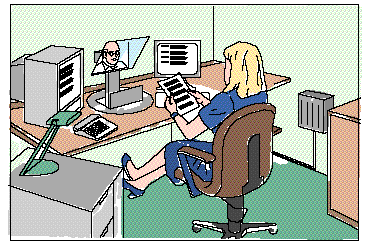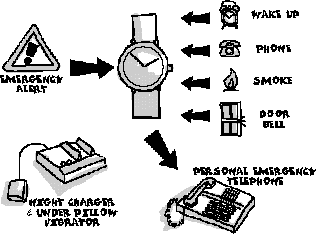


Jan-Ingvar Lindstrom and Mike Martin
Introduction
In everyday life people are all liable to find themselves in an emergency situation and, more commonly, will require to be alerted to signals that give a warning or indication of action to be taken. The means to access services and equipment to ensure safety and comfort are well known, readily available and usually at little or no cost.
One example of this is the access to the Fire, Police and Ambulance services by picking up the telephone and dialling 112, 999 etc. Another example is that people can go into a wide range of stores and buy a very effective smoke alarm for their homes which will probably cost less than ECU 10.
However a disabled person may not be able to use the services that are available because of a disability or find equipment, particularly at low cost, that will ensure personal safety and comfort.
This chapter is in two parts: the first will deal with public emergency services and the second with alarm and alerting systems.
General Principles
As the majority of public emergency services are accessed by telephone, it must be recognized that in principle all telephones are emergency telephones.
Whatever emergency/alarm system is being considered there are three important criteria that must be fulfilled:
1) The system must have very high reliability, ideally 100% or as near to that as is possible. An alarm system that does not have that level of reliability will not generate the feeling of confidence in the user that is essential. Alternatively a system that generates a high degree of confidence but fails at the critical moment can be fatal.
2) The system must transmit a signal to the user that is quite specific and in a form that will alert the user without him (her) having to attend to it.
3) Where the system requires the user to have a response to know they are being attended to, there should be a clear means of identifying that their call has been received and is being dealt with.
The above therefore requires that the interface to the alarm system is configured to meet the needs of the user. While this is an obvious statement, this requirement cannot be met without knowing the needs of the user. Most current systems are designed on the understandable basis of a normal range of human functions, they do not take into account those people who, due to disability, do not have the normal range. In general they also do not take into account that under adverse conditions we all are disabled to some extent. The "market" therefore is wider than what is often seen as a specialist "disabled" one.
In order to have a common approach to the problem, it is necessary to recognize that there are probably four categories of impairment which need separate consi-deration in designing emergency systems:
a) hearing and speech;
b) visual;
c) physical;
d) cognitive.
There also has to be a recognition that these impairments often do not occur in isolation and a person may be unfortunate enough to have two or more impairments which is often the case with elderly people.
a) Hearing and speech impairment
People with hearing impairment are in general elderly and represent some 10% of the general population and over 50% of the population over 65. They can be functionally divided into people who can benefit from amplified sound and those who cannot.
Those who can benefit from amplification will also, in general, be greatly disadvantaged by the presence of background noise which will make it very difficult or impossible for them to recognize speech. For those who use hearing aids the availability of inductive coupling to telephones provides a means of minimizing some of these problems.
For people who cannot benefit from amplification, who number some 1% of the general population, there is a need to provide an alternative means of access which currently has to be by the use of text phones.
A small proportion of this group, due to being born profoundly deaf, will not have written language and would require sign language communication.
The profoundly deaf group also share the same problem as people with speech impairment who cannot make themselves understood over the telephone but who can hear what is being said.
b) Visual impairment
Visually impaired people vary from those who have some functional vision to those that have none. Whichever group is being considered, it is important that the presence of an emergency telephone is easily identified.
For those who have some vision, the need to have clear and highly contrasting markings, together with as high a level of light as possible, is necessary to enable them to use the telephone. A consistent layout for telephone dialling pads ensures more accuracy and is of paramount importance to people with little or no residual vision. For this group, the availability of some form of locating tactile indicator on the dialling pad is essential. An easily identifiable emergency button on public telephones is crucial for visually impaired persons.
c) Physical impairment
Physical impairment comes in a wide range of forms but, in general, can be divided into upper and lower limb difficulties. For people with lower limb problems the diffi-culty is access to the telephone and for people in wheel chairs many public telephones may be inaccessible. For people with upper limb impairments the problem may well lie in the inability to lift the telephone or dial the number.
d) Cognitive impairment
Cognitive impairment may cause an inability to read, speak or understand and the ease of access to services will have a profound effect on the ease of use, or indeed the ability to use a service at all. A very significant group in this category is that of elderly people with senile dementia, particularly those with the disease in its early stages who are still coping with their home environment. For people with mental disabilities simple key pads with standardized layouts and emergency buttons are crucial.
Emergency Services
The most widely known emergency services are those of the Police, Fire and Ambulance; however, public utilities such as Gas and Electricity companies run their own services. Most motorways have emergency breakdown telephones and motoring organizations operate emergency breakdown services. In addition local authorities and other organizations operate social alarm services for elderly people which are very much part of the emergency service system. In some countries national alarm services exist to broadcast to the country or area as a whole that a national disaster is taking place. There are therefore a wide range of services which in most cases have no common approach or policy to the problem of disabled people accessing their services.
While there is a focus on the technical aspects of emergency services which allow access, the question of staff training is often minimized. The ability to communicate often relies on the skills of the operator in the service centre as much as the efficiency of the technical equipment.
In many countries the funding of emergency services has come from central government sources, but the cost of additional facilities to give disabled people access raises questions as to how these shall be paid for. In addition the increase in the numbers of operators in the increasing competitive market raises the question as to how emergency services shall be implemented for disabled people when there are many operators in the market. The main question is: should new operators have the same obligations as the previous state monopolies and should they have to pay for the special services or should the service be paid for from state subsidies or from levies on the general public? In many cases settling these questions can delay or prevent the introduction of services.
A further question is whether the special emergency services should be integrated into the main service or whether it should be handled separately by special agencies. If the service is separate it raises the question as to the availability and access to databases and other network facilities provided specifically for emergency services.
A final issue is the publicizing of emergency number facilities to all disabled people which requires long term costly publicity campaigns.
Social alarms are emergency services, often operated by local authorities, where an elderly person has a terminal in the home which is connected through the public telephone network to a service centre. In an emergency the elderly person activates an alarm button, often worn as a pendant, which causes the terminal to auto-dial the service centre who have on record all relevant details of the individual. The control centre can talk to the caller and determine the problem and arrange for appropriate assistance. In the event of no contact, the centre calls the police or ambulance service. These services provide many elderly people who live on their own with the confidence to remain living at home with the knowledge that if there is an emergency they have the means to make contact to obtain immediate help.
The introduction of special facilities for emergency services therefore raises many complex issues which in the main are political or administrative rather than technical.
Alarm Systems
Alarm systems range from the simple alarm clock to sophisticated burglar alarms and national warning systems. They may be stand alone devices or be complete systems involving control centres to support the end user.
An alarm system always has two functions. The first is to draw attention to the fact that something is happening and the second is to what is happening and consequently that certain actions have to take place.
In many cases the signal also carries the messages for what has to be done. For example when the alarm clock or the telephone bell rings the response is obvious. The same is true for car horns. However it is more complicated when an alarm for a machine malfunction or for a national disaster alarm occurs, as a series of alternative procedures may have to be undertaken, some of them new and unpractised.
There are three categories of alarm system of which two have as a common denominator the fact that they generate signals in the immediate area of the user and that they only cover a small area i.e. personal alarms, impersonal alarms and disaster alarms which are intended to give warnings over large areas.
Personal alarms are for individual use and are found in everyday situations i.e:
- alarm clocks;
- doorbells;
- telephone bells;
- timer signals;
- machinery warning or indicating signals.
Impersonal alarm signals are intended for everyone who happens to be within the physical area of the alarm and are not intended for one specific person. Examples are:
- horns of approaching vehicles;
- sirens or other signals from emergency vehicles;
- fire and emergency evacuation alarms.
Disaster alarms are sent out by national or local authorities to indicate the presence or likely presence of a major incident that is likely to effect a wide geo-graphical area. The alarm signals for such incidents are often acoustic sirens or loudspeaker announcements from public services or verbal announcements on radio and television. Examples of this are:
- poisonous discharges from industrial plants;
- large scale fires, such as forest fires and oil spillage;
- warfare or terrorist activity.
Examples of Current and Future Emergency and Alarm Services
a) Emergency service for deaf and speech impaired people
The main approach to solving the difficulties that deaf and speech impaired people have is by using text telephones in conjunction with a service centre equipped with appropriate equipment and staff trained to communicate with deaf people. The most up-to-date systems allow for people who are deaf but have intelligible speech to speak directly to the operator who can reply by typing back to the textphone.
In the UK the national relay service "Typetalk" is now operating a national emergency service but it will not be accessed through the UK 999 emergency services and will require an eight or nine digit number until some agreement can be reached on a short form number. The availability of short form numbers is a problem due to limited availability and commercial pressures to have them.
Currently many police forces in the UK are offering access, as are other organizations, by means of text phones but with no indication of the communication protocols to be used and no agreement on a common communication standard. This is also an indication of the problems that arises because of the reluctance of government or regulatory bodies to introduce mandatory standardization of certain key protocols. The arguments for not intro-ducing mandatory standards are that it may inhibit market development and that market forces will solve the problem. This will not be the case where no commercial market is being actively pursued and the end result is in fact the opposite of what was intended, leaving deaf and speech impaired people without a national or international system of emergency text phones.
b) Social alarms
The widespread use of what are often called "social alarms", which provide an emergency call service mainly for elderly people has raised the question as to how to enable people with disabilities to also use the services and how to extend those services to cover other needs. This aspect is also very important from the widely accepted point of view of wanting to keep people in their own home as long as possible.



(Figure 4-27) An experimental development using videotelephones within the RACE - APPSN project. Courtesy of SEL-ALCATEL.
An experimental project is illustrated in Figure 4-27 where videotelephony is used to provide an interactive service for elderly people living alone. This service relies on a service centre which provides general support and information as well as dealing with emergencies.
For prelingually deaf people and also those with cognitive impairments the use of video telephony is an important facility that will allow rapid and accurate communication to take place in an emergency situation.
c) Mobile telephones and multimedia systems
Mobile telephones have provided a versatile means of providing access to emergency services. They also cover a wide range of applications which affect able bodied people, such as women on their own, people in wheel-chairs who cannot quickly get to a conventional phone, disabled drivers who cannot access emergency telephones on motorways etc.
An example shown in Figure 4-28, especially useful for people with mental disabilities, is the ISAAC Newton Mobile terminal. It is under development at the University of Technology in LUND and is based on an Apple Newton portable computer. The device will allow mobile communication, including positioning and the trans-mission of video pictures to a safety centre.
d) Integrated alarm system
The TIDE-FASDE project (Future Alarm & Awareness Services for the Disabled & Elderly) has taken an integrated approach to the problems of deaf people and elderly people being alerted to both personal and impersonal alarms as shown in Figure 4-29. A major problem for alarm systems is in warning the person who cannot hear and providing the person with a means of alerting the control centre of a problem. The use of a watch as both a vibratory alarm and also as the push button to attract attention neatly solves two difficult problems. The fact that the watch also functions as a real watch makes it inconspicuous in use and ensures that it will be worn for long periods of time. Another example of a similar system with a vibrating watch is shown in Figure 4-30.

(Figure 4-29) The integrated FASDE alarm system using a vibrating watch.
e) Analogue equipment to existing services
Many disabled and elderly people could use existing emergency services if they had appropriate terminal equipment. The FMN (Fernmeldetechnik Nordhausen GmbH) help telephone (see Figure 4-31) is an example of a telephone that has been designed in Germany to allow as many people as possible to access emergency services by means of a small number of additional features. The functions include a single button to activate sequence of dialling to four emergency numbers based on the users priority.
The FMN Help telephone represents a family of newly designed analogue "comfort" telephones, that incorporate features which both average and disabled users need and like to use. The user-machine interface has been care-fully designed and optimized, even for complex functions.
Main "comfort" functions include: LCD display for dialling number, hands-free and amplification facility, EEPROM memory of all functions and some dialling numbers.
Main emergency functions include: water resistant remote control, additional sensor, automatic cyclic dialling of four numbers, automatic emergency call every 24 hours, 40 second spoken message for emergency call and automatic switching on the hands-free facility.
Conclusion
A large proportion of elderly people need some form of easy to use emergency system which gives them the confidence to live normal lives in their own homes. A significant proportion of elderly people have additional disabilities which makes access to alarm and emergency systems difficult if not impossible. In addition there is a very large number of people who are not elderly but who have the same problem due to a disability. A significant group and one which feels most threatened by the prospect of having to use an emergency service is that of deaf and speech impaired people. Technology offers a way forward in many cases but this progress is hampered by political and administrative obstructions. There is a need to obtain agreement on legislative matters as well as technical standardization of system operations in order to provide services that truly mirror those available to people who have no disabilities.